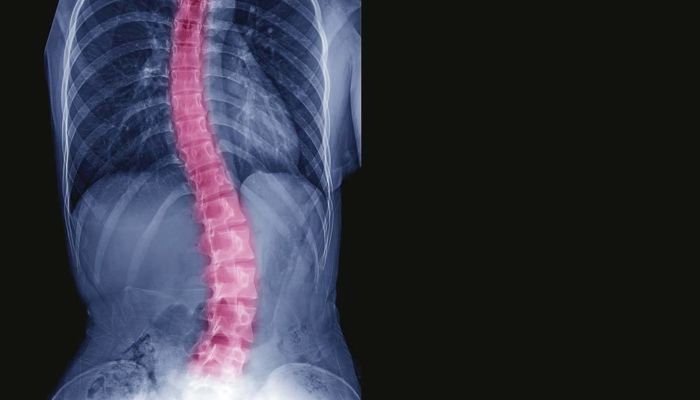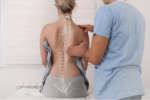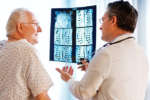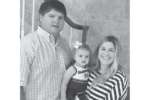Scoliosis is a disorder of the spine that can occur at any age, but usually after the age of 10. Because its main symptom is a curvature of the spine, there aren’t many treatments other than surgery to correct the spine; however, milder cases of a spinal curve can just be observed, and patients can have a high quality of life with little to no complications. Read on to learn more about scoliosis, its symptoms and what causes it, and possible treatment options including surgery.
What Is Scoliosis?
Fundamentally, scoliosis is an abnormal curve of the spine. The backbone (or spine) does have a natural curve, but that curve should only be visible when looking at the spine from the side. If you’re looking from the front at the spine, there should be no curve. In patients with scoliosis, there is a pronounced curve when looking at the backbone from that angle. If the spine is bent forward, the medical terminology for this is called kyphosis, and if it is bent backward, then it is called lordosis. Many cases of scoliosis are mild, and the spine is bent at a 10-20 degree angle. More moderate cases of scoliosis involve a 20-50 degree curve, while severe cases of the condition have a greater than 50-degree curvature.
Scoliosis can begin at any age, and it can occur in both girls and boys. However, most cases are diagnosed after the age of 10, and girls are two times more common to have a scoliosis diagnosis than boys.
What Causes Scoliosis?
There are several different types of scoliosis, and some have clear causes while others do not. Generally speaking, most often doctors don’t know the exact cause of scoliosis, and this type of condition is known as idiopathic scoliosis. This is further divided into age groups:
- Infantile idiopathic scoliosis: Also known as early-onset idiopathic scoliosis, this type is diagnosed in an infant or toddler under the age of 3.
- Juvenile idiopathic scoliosis: This type is diagnosed in young children between the ages of 3 and 10 years of age.
- Adolescent idiopathic scoliosis: This is diagnosed at age 10 or later.
While an adult could certainly receive a diagnosis of idiopathic scoliosis, the problem forms in adolescence, which is why it is separated into these three types. In other words, an adult may seek treatment for scoliosis in adulthood, but more likely than not, the problem existed since they were in their teens or prior.
Over 80 percent of cases diagnosed are idiopathic scoliosis, meaning that doctors can find no clear cause of the problem. However, 20 percent of cases are other types of scoliosis, which have a more direct and apparent cause. These include:
- Neuromuscular scoliosis: This is a problem concerning the way the bones of the spine have formed at birth. This type of condition is usually comorbid with another medical problem, such as cerebral palsy or connective tissue diseases. It may not always be present immediately at birth, but it usually appears soon after.
- Degenerative scoliosis: This is the type of scoliosis that does occur in older adults, and isn’t representative of childhood idiopathic scoliosis. Degenerative types often appear in older patients who suffer from conditions such as osteoporosis or disc degeneration.
- Functional scoliosis: This type of scoliosis involves a curvature in the spine, but a direct cause can be found for it. For example, if a person has one leg that is shorter than the other one, this may cause a curve in the backbone; however, doctors can easily pinpoint the reason.
What Are Risk Factors for Scoliosis?
Because most cases of spinal curve are idiopathic, the risk factors are not clearly defined. Regarding the other types of scoliosis, those who have degenerative bone disease, cerebral palsy, or other issues comorbid with scoliosis are certainly at risk. For idiopathic types, age and gender are certainly a factor. Cases are most likely to be diagnosed between the ages of 9 and 15, and worldwide, 2 percent of girls are diagnosed with scoliosis, compared to 0.5 percent of boys. It is thought that scoliosis is not necessarily genetic. It does not appear that parents or first-degree family members pass scoliosis onto their children.
Symptoms of Scoliosis
The most obvious symptom of scoliosis is a curvature of the spine. If it is not visible with the naked eye, then X-rays are used to make a more definitive diagnosis. Very often, you can visibly see the changes effected by the spinal curve as a patient’s head may suddenly look off-center, or they will slouch. Other scoliosis symptoms may include chest pain or shortness of breath (depending on how severe the spinal curve is) or back pain. Back pain is not terribly common with scoliosis, but it is possible. If a patient is experiencing pain, this is one of the reasons a physician may recommend surgery in order to improve their quality of life.
Scoliosis Treatment and Scoliosis Surgery
Because scoliosis is often diagnosed in relatively young children, such as ages 9 to 15, the most common form of initial scoliosis treatment is simple observation. This means that you’ll work closely with your physician to keep an eye on the curvature of the spine and if it becomes worse in severity. Observation is the first-line course of treatment in younger children who have a 10-20 degree curvature of the spine. Puberty can also change the outcome of scoliosis, which is another reason doctors are not quick to act after initial diagnosis.
If a case of idiopathic scoliosis has a curvature of 20 degrees or more, treatment options include the recommendation of a scoliosis brace for the back to help the spine. Unfortunately, a back brace cannot correct the spine and make it straight. What it can do is slow the progression of the curve. If a brace is worn between 16 and 23 hours out of the day while a patient is still growing, then the likelihood of needing corrective surgery as an adult to correct the curve is much less. Physical therapy and occupational therapy are also good scoliosis treatment options at this juncture.
Severe spinal curves will come with a recommendation for surgery. A curve beyond 40 degrees is expected to worsen. While scoliosis generally isn’t serious, a curve of this magnitude can affect how the lungs function over time, so surgery (spinal fusion surgery) is often recommended. During this surgery, the surgeon will fuse the bones in the back so that when the child has stopped growing, there will be one long, non-curved bone.
Non-idiopathic types of scoliosis may have separate treatment options. For example, degenerative scoliosis is often made better by physical therapy and exercises you can perform at home to strengthen the bones.
Scoliosis Exercises You Can Do at Home
There are a few scoliosis exercises you can try at home, particularly if you have degenerative scoliosis. As always, please check with your doctor before beginning any exercise program. These exercises include:
- Upward and downward dog (yoga) positions: Push your hips back and up while in a prone plank position. Hold for 2 seconds. Lower your hips. Repeat this for multiple sets; however, if you experience pain, make sure to take a break.
- Split stance: Step forward with your longer leg and exaggerate the stance. Keeping your torso upright, switch your weight back and forth on either foot, allowing your knee to bend. Reach up and stretch with the opposite arm of the leg that is stretched forward. Try to reach for the sky. Do not switch sides with this exercise, only performing it on the side where you have the longer leg. Repeat in multiple sets.
Exercise cannot cure scoliosis, but stretching can help with pain caused by scoliosis and can help make you feel more comfortable. If you need more information on scoliosis or would like to be seen by one of our specialists, request an appointment at NewSouth NeuroSpine today. Mississippi's premier spinal center specializes in many areas of spinal intervention and offers individualized, thorough care.






